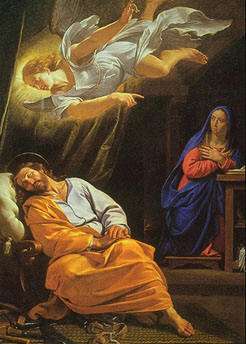Matthew 1:20

Matthew 1:20 is the twentieth verse of the first chapter of the Gospel of Matthew in the New Testament. Previously Joseph had found Mary to be pregnant and had considered leaving her. In this verse an angel comes to him in a dream and reassures him.
In the King James Version of the Bible the text reads:
- But while he thought on these
- things, behold, the angel of the
- LORD appeared unto him in a dream,
- saying, Joseph, thou son of David,
- fear not to take unto thee Mary thy
- wife: for that which is conceived
- in her is of the Holy Ghost.
The World English Bible translates the passage as:
- But when he thought about these
- things, behold, an angel of the
- Lord appeared to him in a dream,
- saying, "Joseph, son of David,
- don't be afraid to take to yourself
- Mary, your wife, for that which is
- conceived in her is of the Holy Spirit.
For a collection of other versions see BibRef Matthew 1:20
This is the first of several dream sequences in Matthew. Like the others, but unlike those of the Old Testament, these dreams are very straightforward with no interpretation required.
Albright and Mann note that while the Greek word angelos is commonly translated as angel it could just as well mean a generic divine messenger. The portrayal of an angel in this verse does not match the more common version, which has them appear as men like beings in the physical world.[1]
The angel refers to Joseph as the "son of David". This again emphasizes Jesus' legal Davidic status, the theme of the earlier genealogy.
By "take Mary as your wife" the angel is referring to the second stage of the Jewish marriage ritual that saw the bride move into the husband's house. The Greek, and the content of the rest of the chapter, makes clear that take is not a euphemism for sexual relations.[2]
Why Joseph should "fear" to love Mary is an important question. Gundry asserts that if he suspected Mary of adultery he would not be in fear. Gundry thus feels that this choice of words demonstrates that Joseph knew of the Virgin Birth before the dream and his fear was in angering God by interfering in his divine plan. This is in keeping with Luke where Mary has already been informed for some time before about the nature of her pregnancy.[3] Boring notes that "do not be afraid" is a standard angelic opening line in the Bible that also appears in Genesis 21:17, Matthew 28:5, Luke 1:13, Luke 1:30, and Revelations 1:17.[4]
The same note about the use of the term Holy Spirit applies here as in Matthew 1:18. The author of Matthew refers to a divine spirit in general, not the specific nature of the Holy Ghost of the Trinity which would only be developed some time later.
The word most often translated as conceived, does not specifically mean biologically conceived. As in English it can also more generally mean created or imagined. Jane Schaberg argues that this verse thus does not rule out the idea that Jesus could also have had a human biological father. She notes that the same verb is used at Galatians 4:29 to refer to Isaac, and repeatedly in John to refer to all Christians. Thus to Schaberg the verse can be read as the holy spirit influencing a child already conceived by natural means.[5]
References
- ↑ Albright, W.F. and C.S. Mann. "Matthew." The Anchor Bible Series. New York: Doubleday & Company, 1971.
- ↑ Brown, Raymond E. The Birth of the Messiah: A Commentary on the Infancy Narratives in Matthew and Luke. London: G. Chapman, 1977.
- ↑ Gundry, Robert H. Matthew a Commentary on his Literary and Theological Art. Grand Rapids: William B. Eerdmans Publishing Company, 1982.
- ↑ Boring, Eugene "Gospel of Matthew." The New Interpreter's Bible, volume 8 Abingdon, 1995 pg. 134
- ↑ Schaberg, Jane. "Feminist Interpretations of the Infancy Narrative of Matthew." Journal of Feminist Studies in Religion. 1997 Indiana University Press. pg. 51
| Preceded by Matthew 1:19 |
Gospel of Matthew Chapter 1 |
Succeeded by Matthew 1:21 |
| ||||||||||||||
| ||||||||||||||||||||||||||||||||